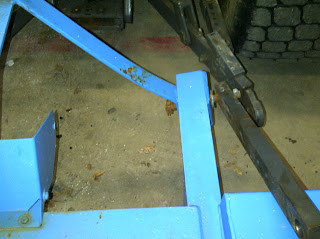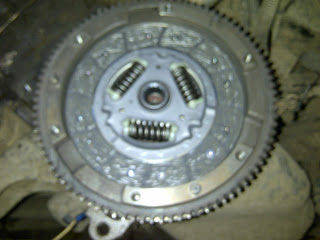First time doing this job on the lift . Took about 2 hrs + - . I have remove the transmission a few times using jack stands . I start by removing the battery cables on the battery . Next I'll disconnect the shifting cables on the transmission I think it was 7/8 nut and pull the clips . Remove the clutch cables .
On the passenger side there are a bunch of ground cables that have to be removed from transmission .
Remove the 3/4 " nut on the rear end drive shaft yoke . Don't lose the special washer in behind the nut . I used a large pry bar in the universal joint to hold it steady to loosen off .

Next I place the tripod jack under it till I'm ready to pull it out . Remove the muffler hanger of the transmission bracket . Next I take the 4 bolts of the top of the transmission bracket ( I'll show you in the pics below ). Remove the 2 - 10mm bolts that hold the inspection cover . Remove the cover plate . If your under the machine facing the front there are 2 nuts on the backside of transmission .. one top right ( remove it from under the machine it's a tight spot ) and the other bottom left . There are 2 bolts on either side of were the starter came off . Now in the book it says to remove the rear transmission mount , I leave it on it helps hold it there till I'm ready to remove it . The drive shaft will not come out of rear end unless you lift up and to the passenger side . now your ready to wiggle the transmission out ( I removed the gear oil to lighten it up a little and prevent a mess . ) The manual says it's a 2 person job but I'm able to do it alone this way with not to much problem . Transmission I'm guessing weighs 25 to 30 lbs.

Clutch and pressure plate on motor side . I placed a piece of 2x2 to on the top side of the oil pan to keep the motor from moving back and forth . There is a metal spacer that goes around 3/4 of the bell housing . You can remove that also .
The right side of pic still has the transmission mount on it . I leave it on because it helps me keep it in place when it gets reinstalled . The metal looking levers on the right side sit in a similar piece on the machine sort of like a cradle.
Remove the 6 or so bolts holding the pressure plate on the flywheel .
It's a fairly good size job so I usually replace the throw out bearing to . Slide the bearing of the shaft by pulling the clutch lever . To get the bearing off the arm ( in this case ) slide the clutch shaft in to release it off the pin on the bearing .
New throw out bearing . I put a little never seize on the shaft to help it slide .I had an e-mail recently pointing out that the spring may not be fully connected and they are right . It's suppose to attach to the catch in the casing on the left were the shaft comes through the case . ( Thanks for the e-mail )
Originally I though the clutch was worn out but when I removed the pressure plate I noticed in one section the spring was broken .
Clutch alignment tool . I have had good success using a broom handle to center the clutch while tightening bolts on the pressure plate .
Check the bearing for wear . This one actually has a bearing . A lot of machines have just a brass bushing . Clean of the flywheel and scuff it of with sand paper a little bit to get the glaze off . If it's blueish looking and scored your better off replacing the fly wheel . You can take them to a machine shop if their not burnt and get them to turn a little metal of .
Set the clutch in ,Face the side that sticks out towards the transmission .
Clutch alignment tool .
When I'm ready to place the transmission in I set the tri pod on the front side of the motor for support. If your alignment is dead on it may just slide in . If not wiggle it back and forth and up and down . If it's still giving you trouble and the the transmission shaft has started in the clutch you can put one of the levers in gear on transmission and stick the drive shaft in and give it a bit of a turn till you feel the teeth line up , Then you can push on the clutch lever and it should slide in enough to get the bolts in . ( Don't forget to put the spacer plate in on engine before you start installing transmission ) tighten bolts and nuts up evenly till its back in place. .
Remember my cradling levers on the transmission . I have to push up and to the passenger side to get the drive shaft back in place . ( pick below )
Now you can install every thing back on muffler hanger, transmission bracket bolts , rear yoke bolt and special washer , clutch cable , shifting cables , ground wires ( clean them well first ) starter and wires . hook battery cables up . Put the inspection shield back on . It should be good to go . This one is.The Gardener couldn't be any happier . He loves his Cushman being Welsh and all .












































 i
i








